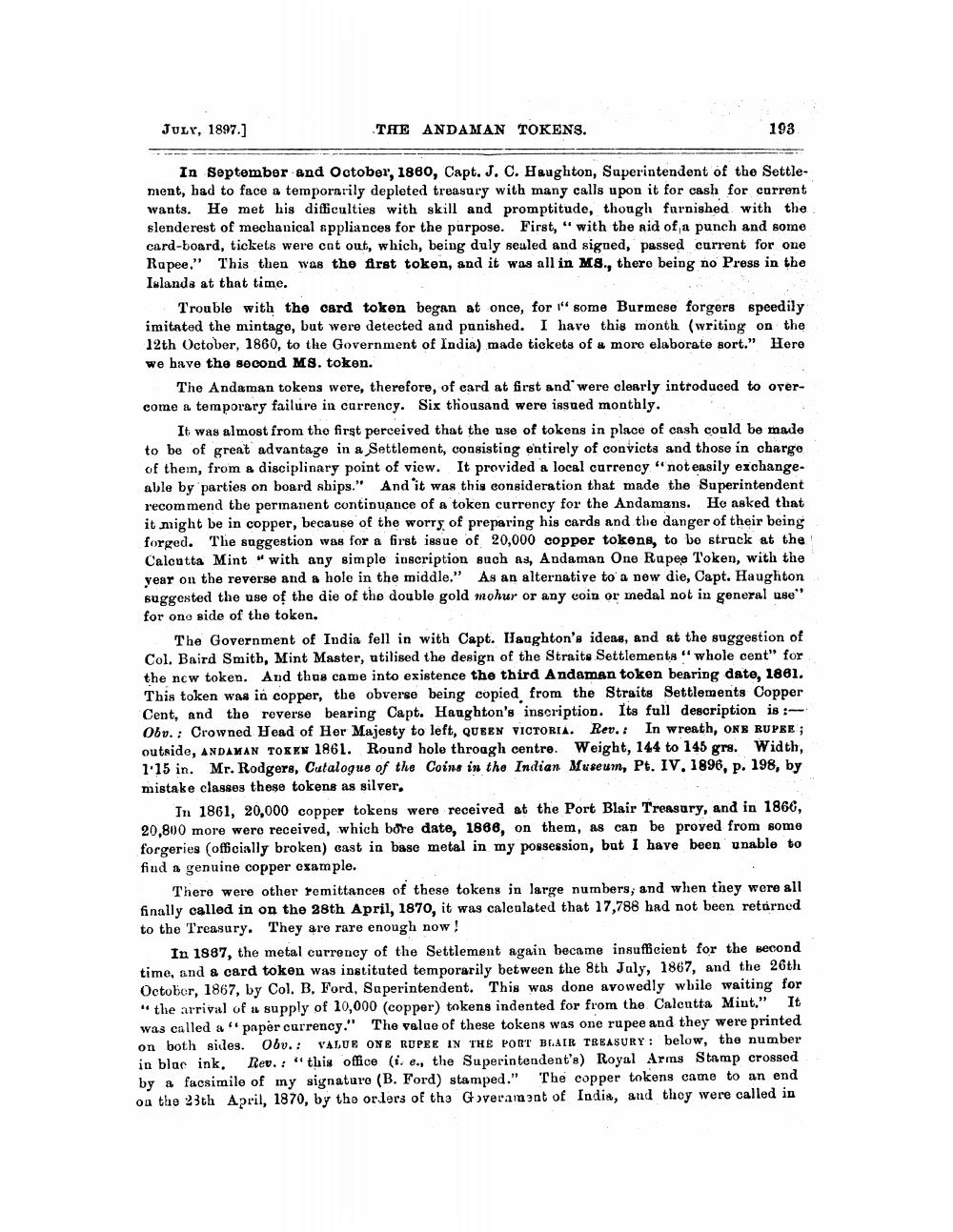________________
JULY, 1897.]
THE ANDAMAN TOKENS.
193
In September and October, 1860, Capt. J. C. Haughton, Superintendent of the Settlement, had to face a temporarily depleted treasury with many calls upon it for cash for current wants. He met his difficulties with skill and promptitude, though furnished with the slenderest of mechanical appliances for the parpose. First," with the aid of a punch and some card-board, tickets were cnt out, which, being duly sealed and signed, passed current for one Rapee." This then was the first token, and it was all in M8., there being no Press in the Islands at that time.
Trouble with the card token began at once, for "some Burmese forgers speedily imitated the mintage, but were detected and punished. I have this month (writing on the 12th October, 1860, to the Government of India) made tickets of a more elaborate sort." Hero we have the second Ms. token.
The Andaman tokens were, therefore, of card at first and were clearly introduced to overcome a temporary failure in currency. Six thousand were issued monthly.
It was almost from the first perceived that the use of tokens in place of cash could be made to be of great advantage in a Settlement, consisting entirely of convicts and those in chargo of them, from a disciplinary point of view. It provided a local currency "not easily exchangeable by parties on board ships." And it was this consideration that made the Superintendent recommend the permanent continuance of a token currency for the Andamans. Ho asked that it might be in copper, because of the worry of preparing his cards and the danger of their being forged. The suggestion was for a first issue of 20,000 copper tokens, to bo struck at the Calcutta Mint " with any simple inscription such as, Andaman One Rupee Token, with the year on the reverse and a hole in the middle." As an alternative to a new die, Capt. Haughton suggested the use of the die of the double gold mohur or any coin or medal not in general use" for one side of the token,
The Government of India fell in with Capt. Haughton's ideas, and at the suggestion of Col. Baird Smith, Mint Master, utilised the design of the Straits Settlements "whole cent" for the new token. And thus came into existence the third Andaman token bearing date, 1861. This token was in copper, the obverse being copied from the Straits Settlements Copper Cent, and the reverse bearing Capt. Haughton's inscription. Its full description is :Obv.: Crowned Head of Her Majesty to left, QUEEN VICTORIA. Rev.: In wreath, ONE RUPEE ; outside, ANDAMAN TOXEN 1861. Round hole through centre. Weight, 144 to 145 grs. Width, 1.15 in. Mr. Rodgers, Catalogue of the Coins in the Indian Museum, Pt. IV. 1896, p. 198, by mistake classes these tokens as silver,
In 1861, 20,000 copper tokens were received at the Port Blair Treasury, and in 1866, 20,800 more were received, which bore date, 1888, on them, as can be proved from some forgeries (officially broken) cast in base metal in my possession, but I have been unable to fiud a genuine copper example.
There were other remittances of these tokens in large numbers, and when they were all finally called in on the 28th April, 1870, it was calculated that 17,788 had not been returned to the Treasury. They are rare enough now!
In 1887, the metal currency of the Settlement again became insufficient for the second time, and a card token was instituted temporarily between the 8th July, 1867, and the 26th October, 1867, by Col. B. Ford, Superintendent. This was done avowedly while waiting for “the arrival of a supply of 10,000 (copper) tokens indented for from the Calcutta Mint." It was called a "paper currency." The value of these tokens was one rupee and they were printed on both sides. Obv.: VALUE ONE RUPEE IN THE POET BLAIR TREASURY : below, the number in blae ink, Rev.: "this office (i. e., the Superintendent's) Royal Arms Stamp crossed by a facsimile of my signature (B. Ford) stamped." The copper tokens came to an end on the 23th April, 1870, by the orders of the Goverannt of India, and thoy were called in




